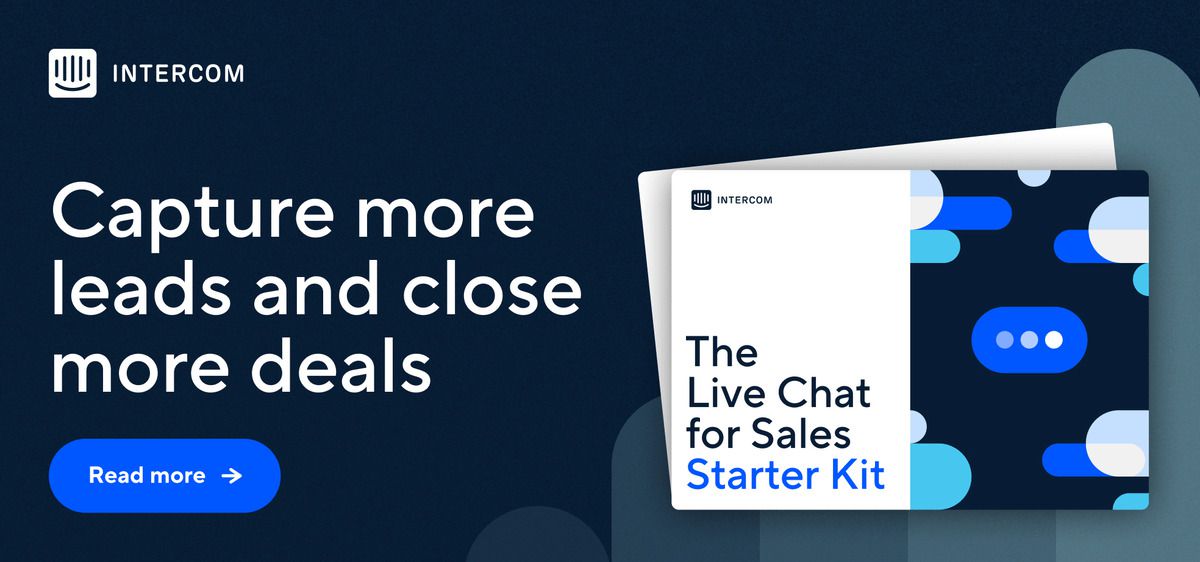
From first touch to qualified lead: How to use live chat for sales
Main illustration: Yevgenia Nayberg
The promise of live chat for sales teams is being able to connect faster with higher quality leads. But any target-focused sales professional will want to know: how well does live chat actually work?
Live chat – especially when it’s part of a modern customer communications platform that helps you make the most of every engagement – is a powerful addition to your sales tech stack. Using live chat as part of your sales funnel can grow your pipeline, help your team to work more efficiently, and ultimately boost conversion rates. Not only are the leads coming in through live chat of higher quality, they’re also 82% more likely to convert.
Want to get started with live chat for sales? Here’s what you need to know.
Why live chat is the missing ingredient in your sales funnel
For many years, B2B companies have executed their inbound sales funnel in a traditional manner that looked a little something like this:
- Visitor prospects
- Lead
- Marketing qualified lead (MQL)
- Sales qualified lead (SQL)
- Opportunity
- Customer
Much like the word “funnel” suggests, the idea of the inbound sales funnel is to filter visitors and leads through each of the above stages, going from a large volume (visitor prospects) to a smaller but more relevant volume of opportunities that are ready to buy.
This traditional sales funnel requires multiple touches in order to qualify the lead and move them through the funnel. This can involve calls, emails, targeted messages, and other highly personalized one-to-one outreach.
“Using live chat for sales means that you have an always-on lead qualification machine at your fingertips, allowing you to reduce the number of stages in your sales funnel without reducing lead quality or customer experience”
Unsurprisingly, this traditional approach takes time. This means that your sales team can get stuck in an endless cycle of lead qualification and nurture, instead of spending time where it really matters: building relationships with prospects and closing deals.
Using live chat for sales, you can:
- Qualify inbound leads using customizable bots that ask relevant, targeted questions.
- Capture customer data that helps you to personalize your sales outreach and improve the customer experience.
- Route conversations to the right people based on customized criteria that works for your team (for example, industry, region, or company size).
- Schedule meetings right from within the Business Messenger, so you never miss a chance to connect.
- Use targeted messages to share relevant content or case studies that can help to persuade prospects and move them further down the funnel.
- Maintain sales hygiene by integrating with the other essential tools in your sales tech stack to ensure that your data is always up-to-date and synchronized.
- Shorten sales cycles by giving prospects the information they need in real time, by giving automated answers to frequently asked questions or routing them directly to their sales rep.
All of this means that you have an always-on lead qualification machine at your fingertips – or more accurately, on your website – allowing you to reduce the number of stages in your sales funnel without reducing lead quality or customer experience. Not only that, but it gives your sales reps more time (and deeper insights) to do what they do best: connect with prospects and turn them into happy customers.
Increase your leads without increasing your headcount
One of the biggest concerns that people have about live chat for sales is that it’ll open the floodgates to an endless stream of messages that will drown your team.
But one of the major benefits of live chat for sales is that it allows you to capture and qualify more leads without needing to increase headcount. That’s because while your SDRs are still on hand to chat to customers and answer queries, you can also leverage bots to manage conversation volumes and answer simple questions.
“Live chat makes the sales process – and your SDRs – more efficient”
With live chat, your SDRs aren’t spending time researching, deciding how to best reach out, personalizing an email template or even making a phone call; they are simply saying hello and having a conversation. We’ve found that live chat leads typically take less than five minutes to execute – a much more efficient customer journey for your team to process.
And just as importantly, we can disqualify leads earlier and at a faster rate, usually within two minutes and using less capacity to do so. In other words, live chat makes the sales process – and your SDRs – more efficient.
And speed is of the essence when it comes to converting leads. Research shows that businesses who respond to leads within five minutes are 100 times more likely to convert opportunities.
With a few routing rules and a little help from a bot, your sales reps can easily handle more leads over live chat in the same amount of time. This allows you to cost effectively staff a live chat funnel while increasing conversion rates across your sales funnel.
3 ways live chat optimizes the sales funnel
1. Live chat is more efficient
Not only can your SDRs and sales reps handle more conversations via live chat, but by using a customer communications platform you can maximize those efficiency gains. By using bots and automation to ask qualifying questions, quickly respond to simple queries, provide personalized targeted outreach to prospects, schedule meetings, and more, you can free up more time for your sales team to focus on those meaningful conversations.
2. Live chat leads to higher conversion rates
Our data suggests that website visitors are 82% more likely to convert to customers if they’ve chatted with you in real-time first. What’s more, they spend 13% more than those who don’t. The same research also showed that one reply to a visitor’s live chat message made them 50% more likely to convert; two replies bumped that up to 100% more likely to convert. A quick chat with six messages made them 250% more likely to convert. The takeaway? It pays to chat.
3. Live chat lets you control the flow
Consider placing your live chat widget in areas other than the homepage. A great tip is to include it wherever visitors show the highest intent or buying signals, such as on your pricing page. Visitors are 45% more likely to convert on pages where the intent to purchase is high. You can also opt to route queries for specific landing pages to certain sales reps on your team, based on location, industry, or subject matter expertise.
The business benefits of using live chat for sales
Livestorm booked 233% more sales demos with Intercom
“Intercom really helps us make sense of the traffic that’s hitting our website, as well as to have conversations with these visitors and turn them into leads,” says Thibaut Davoult, Head of Growth at Livestorm. “The number of monthly inbound demos booked has increased by 233% since we started using Intercom to power our sales.”
Unity’s inside sales team drove 80% of its revenue through live chat
Within the first 3 months of implementing Intercom, 80% of Unity’s inbound inside sales revenue was driven by live chat. “Intercom enables us to build relationships with our prospects and customers across every touchpoint of our customer lifecycle,” says Jesus Requena, Former Director, Paid Subscriptions at Unity. “It’s played a critical role in growing Paid Subscriptions business and allows us to create a more personal customer experience.”
Envoy accelerated lead volume through Intercom
“Intercom dramatically increased our volume of leads – and we saw another jump when we added auto messages,” says CathyLee McNeill, Former Account Development Representative Manager at Envoy. Leads generated by Intercom now make up 33% of Envoy’s leads.
Letting humans be humans
Live chat is an essential part of any modern sales process and for good reason. It enables sales reps to do what humans are best at: having high-value, high-quality conversations.
While live chat doesn’t replace email, phone, or in-person meetings, it complements these channels well to enhance your sales pipeline management. There’s no better tool for optimizing your conversion rates and having the kind of personal conversations with prospects that lead to higher win rates and happier customers.






